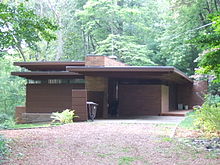Carport
A carport (literally "car port") is a covered parking space for cars that is attached to a residential building or integrated or free-standing .
origin
The term carport was coined in the 1930s by the American architect Frank Lloyd Wright , who equipped his “ prairie houses ” and later his “ Usonians ” with these shelters . Wright rejected garages because, in his opinion, they were not used by the builders for parking cars but as storage rooms. A precursor is for coaches used depot .
construction
A carport is usually made of wood , steel or aluminum , but there are also versions made of plastic . Carports have a flat roof , higher quality versions have more complex constructions such as a gable roof , hipped roof or a barrel roof . A carport can be open on all sides, and elements are also offered with which individual segments can be completely or partially closed. These elements can consist of sheet steel, wood, glass, WPC (Wood-Plastic-Composite), HPL (High-Pressure-Laminate) or polycarbonate double-walled sheets. In contrast to the garage , the carport is open on at least one side. A common variant of the roof covering is a corrugated sheet , trapezoidal sheet or their transparent shapes, corrugated profile light sheets or trapezoidal sheets . Open carports without a roof are mostly used as an optical border for outdoor parking spaces in order to highlight them from the surrounding open spaces. The free areas of the roof are also increasingly being used for solar systems and for extensive green roofs.
Advantages and disadvantages
The advantages of the carport compared to a garage are, on the one hand, its architectural effect, which gives the building as a whole more lightness and elegance thanks to the open construction, and supplies adjoining buildings and areas with more light. Harmful exhaust gases can also flow off better and carcinogenic fine dust can easily escape. Adhering moisture is also removed more efficiently, which means that the vehicle under it dries more quickly and significantly reduces the risk of rust. The free space gained on the roof is increasingly being used as a location for private solar cells that feed energy into the in-house system.
Carports make it possible to display your own car, but offer no protection against theft or willful damage. It is the same with animals such as B. martens possible to tamper with the car.
Structural and legal aspects
The regulations for the construction and operation of carports are usually dealt with in the garage regulations of the federal states. There they are referred to as "open garages". According to the model garage ordinance (M-GarVO), they have non-closable openings leading directly into the open, which are at least 1/3 of the total area of the surrounding walls.
In general, carports are more easily approved than garages, and fire protection requirements are generally not required. In contrast to a garage, only point and no line or area foundations are required. In Germany, according to the regulations that have been in force since 2014, proof of manufacturer qualification according to DIN EN 1090 is required.
Individual evidence
- ↑ The open garage is commonly known as the carport wallstreet-online.de. Retrieved August 26, 2020.
- ↑ The open garage is commonly known as the carport baunetzwissen.de. Retrieved August 26, 2020.



